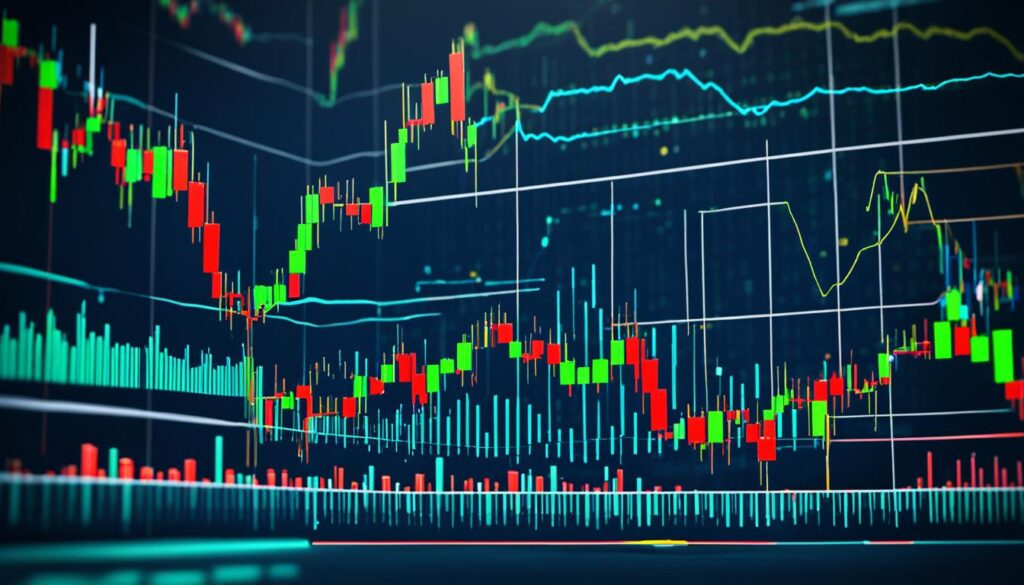Futures trading indicators are powerful tools that can help traders predict market moves and make informed decisions. These indicators provide valuable insights into market trends, price movements, and potential entry and exit points. By analyzing data from various sources, traders can identify patterns, trends, and signals that can guide their trading strategies. Whether you are a beginner or an experienced trader, understanding and using futures trading indicators can enhance your trading strategy and increase your chances of success.
Key Takeaways:
- Futures trading indicators are essential for predicting market moves and informing trading decisions.
- These indicators offer insights into market trends, price movements, and potential entry and exit points.
- Analyzing data from various sources helps traders identify patterns, trends, and signals.
- Using futures trading indicators can enhance trading strategies and increase success rates.
- Traders of all levels can benefit from incorporating futures trading indicators into their strategies.
Importance of Futures Trading Indicators
Futures trading indicators play a crucial role in enhancing trading strategies and identifying trends in the market. These indicators provide valuable insights into market conditions, including price fluctuations, volatility, and momentum. By analyzing these indicators, traders can gain a deeper understanding of potential market movements and make better-informed trading decisions. Whether you are a day trader, swing trader, or long-term investor, incorporating futures trading indicators into your strategy can greatly enhance your ability to navigate the market with confidence.
When it comes to trading, having a comprehensive understanding of market trends is essential. Futures trading indicators serve as powerful tools for spotting these trends and making predictions about future market movements. By identifying indicators such as moving averages, oscillators, and volume indicators, traders can identify patterns and signals that can guide their decision-making process.
For example, moving averages help smooth out price fluctuations and reveal underlying trends, while oscillators can indicate overbought or oversold market conditions. Volume indicators, on the other hand, can provide insights into market participation and the strength of price movements. By combining multiple indicators and analyzing their signals, traders can develop a comprehensive view of the market and make more informed trading decisions.
Additionally, futures trading indicators can be particularly useful for traders who rely on technical analysis. Technical analysis involves using historical price data and trading indicators to predict future market movements. By relying on indicators that have proven to be reliable and accurate, traders can further enhance the effectiveness of their trading strategy.
However, it is important to note that while futures trading indicators can greatly enhance trading strategies, they should not be used in isolation. It is important to consider other factors, such as fundamental analysis and market news, to make well-rounded trading decisions. Traders should also continuously monitor and adjust their indicators based on changing market conditions to ensure their strategies remain effective.

Overall, futures trading indicators are valuable tools that can significantly enhance trading strategies and help traders spot trends in the market. By incorporating these indicators into their analysis and decision-making processes, traders can navigate the market with more confidence and increase their chances of success.
Types of Futures Trading Indicators
There are various types of futures trading indicators that traders can use to analyze market conditions and make predictions. These indicators provide valuable insights into market trends, price movements, and potential entry and exit points. By understanding the different types of indicators, traders can enhance their trading strategies and improve their chances of success.
Moving Averages: Moving averages are widely used indicators that help traders identify trends by smoothing out price fluctuations. They calculate the average price over a specified period and display it as a line on a chart. By comparing the current price to the moving average, traders can determine whether the market is trending up or down.
Oscillators: Oscillators are indicators that help traders identify overbought or oversold market conditions. These indicators measure the momentum and strength of price movements and provide signals when a market is reaching extreme levels. Popular oscillators include the Relative Strength Index (RSI) and the Stochastic Oscillator.
Volume Indicators: Volume indicators provide insights into market participation and the strength of price movements. They measure the number of shares or contracts traded during a specific period and help traders understand the significance of price changes. Examples of volume indicators include On-Balance Volume (OBV) and the Money Flow Index (MFI).
| Type of Indicator | Description | Pros | Cons |
|---|---|---|---|
| Moving Averages | Identify trends | Easy to understand, can be used in different time frames | Delayed signals, may generate false signals in choppy markets |
| Oscillators | Identify overbought or oversold conditions | Provide early entry or exit signals, work well in sideways markets | May generate false signals in trending markets |
| Volume Indicators | Measure market participation and strength | Confirm price trends, detect price reversals | Can be influenced by unusual trading activity |
Each type of futures trading indicator has its own unique formula and interpretation. Traders can choose the indicators that best suit their trading style, objectives, and the specific market conditions they are trading in. It is important to note that no single indicator can guarantee accurate predictions, and traders should consider using a combination of indicators and other forms of analysis to make informed trading decisions.

Choosing and Utilizing Futures Trading Indicators
When it comes to futures trading, choosing the right indicators is a crucial step in developing a successful trading strategy. The selection of indicators should be based on your trading goals, time frame, and risk tolerance. Different indicators excel in different strategies and market conditions, so it’s vital to choose those that align with your specific needs.
Effectively utilizing these indicators is equally important. Understanding how to interpret their signals and incorporating them into your trading approach can make a significant difference in your results. Traders should assess the reliability, accuracy, and real-time data availability of indicators to ensure they provide valuable insights.
Additionally, it’s essential to continually monitor and adjust your indicators to adapt to changing market conditions. Markets are dynamic and constantly evolving, so regularly reviewing and modifying your indicator settings will help optimize their effectiveness.
To maximize the power of indicators, combining multiple indicators and integrating them with other forms of analysis can offer a comprehensive view of the market. By utilizing these indicators hand in hand with other technical analysis tools or fundamental analysis, traders can make more informed decisions and enhance their overall trading strategy.
FAQ
What are futures trading indicators?
Futures trading indicators are powerful tools that help traders predict market moves and make informed decisions. These indicators provide insights into market trends, price movements, and potential entry and exit points.
How do futures trading indicators enhance trading strategies?
Futures trading indicators play a crucial role in helping traders enhance their trading strategies by providing valuable information about market conditions, such as price fluctuations, volatility, and momentum. Analyzing these indicators can help traders gain insights into potential market movements and make better-informed trading decisions.
What are some common types of futures trading indicators?
Some common types of futures trading indicators include moving averages, oscillators, and volume indicators. Moving averages help identify trends, oscillators indicate market conditions, and volume indicators provide insights into market participation and the strength of price movements.
How do I choose the right futures trading indicators for my strategy?
When choosing futures trading indicators, it is important to consider your trading goals, time frame, and risk tolerance. Different indicators are suited for different strategies and market conditions. Additionally, factors such as reliability, accuracy, and real-time data availability should be considered.
How do I effectively utilize futures trading indicators?
To effectively utilize futures trading indicators, it is important to understand how to interpret and utilize them. Traders should continuously monitor and adjust their indicators based on changing market conditions. By combining multiple indicators and using them in conjunction with other forms of analysis, traders can maximize the effectiveness of their trading strategy.
Source Links
- https://www.morningstar.com/news/dow-jones/202403012287/european-midday-briefing-relief-over-us-inflation-spurs-gains-for-stocks
- https://www.fxstreet.com/cryptocurrencies/news/bitcoin-bulls-just-joining-the-rally-are-very-late-to-the-party-analyst-says-202403010919
- https://www.investing.com/analysis/gold-surges-above-2040-bitcoin-corrects-200646487
Disclaimer
All information on this website is of a general nature. The information is not adapted to conditions that are specific to your person or entity. The information provided can not be considered as personal, professional or legal advice or investment advice to the user.
This website and all information is intended for educational purposes only and does not give financial advice. Signal Mastermind Signals is not a service to provide legal and financial advice; any information provided here is only the personal opinion of the author (not advice or financial advice in any sense, and in the sense of any act, ordinance or law of any country) and must not be used for financial activities. Signal Mastermind Signals does not offer, operate or provide financial, brokerage, commercial or investment services and is not a financial advisor. Rather, Signal Mastermind Signals is an educational site and a platform for exchanging Forex information. Whenever information is disclosed, whether express or implied, about profit or revenue, it is not a guarantee. No method or trading system ensures that it will generate a profit, so always remember that trade can lead to a loss. Trading responsibility, whether resulting in profits or losses, is yours and you must agree not to hold Signal Mastermind Signals or other information providers that are responsible in any way whatsoever. The use of the system means that the user accepts Disclaimer and Terms of Use.
Signal Mastermind Signals is not represented as a registered investment consultant or brokerage dealer nor offers to buy or sell any of the financial instruments mentioned in the service offered.
While Signal Mastermind Signals believes that the content provided is accurate, there are no explicit or implied warranties of accuracy. The information provided is believed to be reliable; Signal Mastermind Signals does not guarantee the accuracy or completeness of the information provided. Third parties refer to Signal Mastermind Signals to provide technology and information if a third party fails, and then there is a risk that the information may be delayed or not delivered at all.
All information and comments contained on this website, including but not limited to, opinions, analyzes, news, prices, research, and general, do not constitute investment advice or an invitation to buy or sell any type of instrument. Signal Mastermind Signals assumes no responsibility for any loss or damage that may result, directly or indirectly, from the use or dependence on such information.
All information contained on this web site is a personal opinion or belief of the author. None of these data is a recommendation or financial advice in any sense, also within the meaning of any commercial act or law. Writers, publishers and affiliates of Signal Mastermind Signals are not responsible for your trading in any way.
The information and opinions contained in the site are provided for information only and for educational reasons, should never be considered as direct or indirect advice to open a trading account and / or invest money in Forex trading with any Forex company . Signal Mastermind Signals assumes no responsibility for any decisions taken by the user to create a merchant account with any of the brokers listed on this website. Anyone who decides to set up a trading account or use the services, free of charge or paid, to any of the Broker companies mentioned on this website, bears full responsibility for their actions.
Any institution that offers a service and is listed on this website, including forex brokers, financial companies and other institutions, is present only for informational purposes. All ratings, ratings, banners, reviews, or other information found for any of the above-mentioned institutions are provided in a strictly objective manner and according to the best possible reflection of the materials on the official website of the company.
Forex/CFD trading is potentially high risk and may not be suitable for all investors. The high level of leverage can work both for and against traders. Before each Forex/CFD investment, you should carefully consider your goals, past experience and risk level. The opinions and data contained on this site should not be considered as suggestions or advice for the sale or purchase of currency or other instruments. Past results do not show or guarantee future results.
Neither Signal Mastermind Signals nor its affiliates ensure the accuracy of the content provided on this Site. You explicitly agree that viewing, visiting or using this website is at your own risk.


